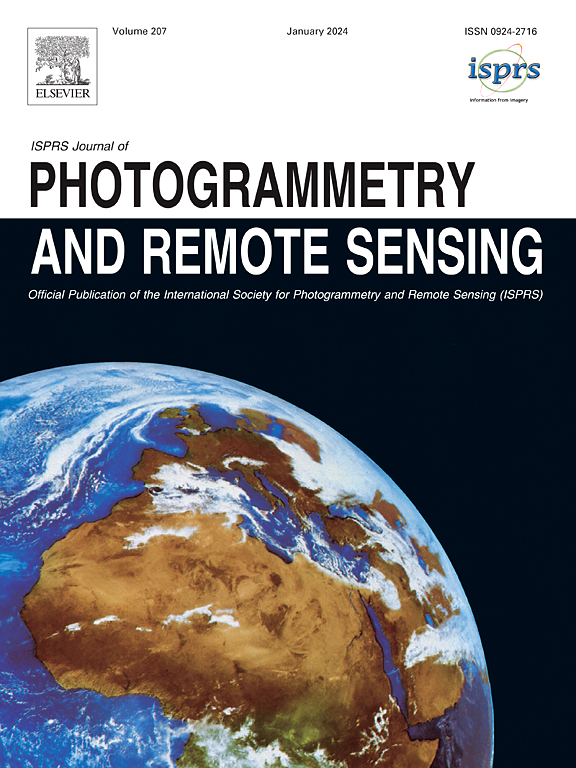Plug-and-play DISep: Separating dense instances for scene-to-pixel weakly-supervised change detection in high-resolution remote sensing images
IF 10.6
1区 地球科学
Q1 GEOGRAPHY, PHYSICAL
ISPRS Journal of Photogrammetry and Remote Sensing
Pub Date : 2025-02-01
DOI:10.1016/j.isprsjprs.2025.01.007
引用次数: 0
Abstract
Change Detection (CD) focuses on identifying specific pixel-level landscape changes in multi-temporal remote sensing images. The process of obtaining pixel-level annotations for CD is generally both time-consuming and labor-intensive. Faced with this annotation challenge, there has been a growing interest in research on Weakly-Supervised Change Detection (WSCD). WSCD aims to detect pixel-level changes using only scene-level (i.e., image-level) change labels, thereby offering a more cost-effective approach. Despite considerable efforts to precisely locate changed regions, existing WSCD methods often encounter the problem of “instance lumping” under scene-level supervision, particularly in scenarios with a dense distribution of changed instances (i.e., changed objects). In these scenarios, unchanged pixels between changed instances are also mistakenly identified as changed, causing multiple changes to be mistakenly viewed as one. In practical applications, this issue prevents the accurate quantification of the number of changes. To address this issue, we propose a Dense Instance Separation (DISep) method as a plug-and-play solution, refining pixel features from a unified instance perspective under scene-level supervision. Specifically, our DISep comprises a three-step iterative training process: (1) Instance Localization: We locate instance candidate regions for changed pixels using high-pass class activation maps. (2) Instance Retrieval: We identify and group these changed pixels into different instance IDs through connectivity searching. Then, based on the assigned instance IDs, we extract corresponding pixel-level features on a per-instance basis. (3) Instance Separation: We introduce a separation loss to enforce intra-instance pixel consistency in the embedding space, thereby ensuring separable instance feature representations. The proposed DISep adds only minimal training cost and no inference cost. It can be seamlessly integrated to enhance existing WSCD methods. We achieve state-of-the-art performance by enhancing three Transformer-based and four ConvNet-based methods on the LEVIR-CD, WHU-CD, DSIFN-CD, SYSU-CD, and CDD datasets. Additionally, our DISep can be used to improve fully-supervised change detection methods. Code is available at https://github.com/zhenghuizhao/Plug-and-Play-DISep-for-Change-Detection.
求助全文
约1分钟内获得全文
求助全文
来源期刊

ISPRS Journal of Photogrammetry and Remote Sensing
工程技术-成像科学与照相技术
CiteScore
21.00
自引率
6.30%
发文量
273
审稿时长
40 days
期刊介绍:
The ISPRS Journal of Photogrammetry and Remote Sensing (P&RS) serves as the official journal of the International Society for Photogrammetry and Remote Sensing (ISPRS). It acts as a platform for scientists and professionals worldwide who are involved in various disciplines that utilize photogrammetry, remote sensing, spatial information systems, computer vision, and related fields. The journal aims to facilitate communication and dissemination of advancements in these disciplines, while also acting as a comprehensive source of reference and archive.
P&RS endeavors to publish high-quality, peer-reviewed research papers that are preferably original and have not been published before. These papers can cover scientific/research, technological development, or application/practical aspects. Additionally, the journal welcomes papers that are based on presentations from ISPRS meetings, as long as they are considered significant contributions to the aforementioned fields.
In particular, P&RS encourages the submission of papers that are of broad scientific interest, showcase innovative applications (especially in emerging fields), have an interdisciplinary focus, discuss topics that have received limited attention in P&RS or related journals, or explore new directions in scientific or professional realms. It is preferred that theoretical papers include practical applications, while papers focusing on systems and applications should include a theoretical background.
 求助内容:
求助内容: 应助结果提醒方式:
应助结果提醒方式:


